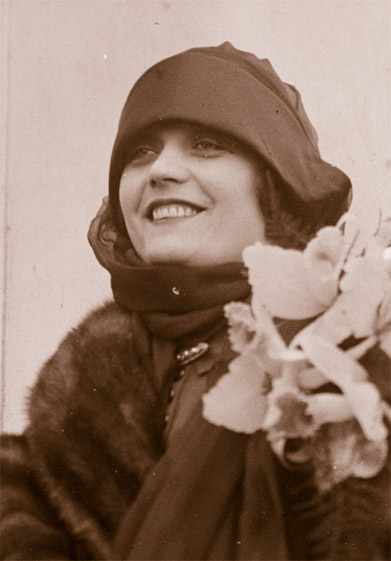-
Silent Star of April 1996
Pola Negri

"Imperious." "Exotic." "Mysterious." Who else but Pola Negri?
She was born Apolonia Chalupec on December 31, 1895 in Lipno, Poland. She became Pola Negri: toast of two continents, rival of Swanson, lover to Valentino. In her last film The Moon-Spinners (1964), her character, Madame Habeb exclaims, "I have survived two wars, four revolutions, and five husbands," a line more relevant to the life of the tempestuous actress than the character she portrayed.An only child, Pola's comfortable childhood was shattered when her father was arrested by the Russian Army and sent to a Siberian gulag. She and her mother moved to Warsaw, where she spent her childhood and early teens in poverty. With the help of neighbors, Pola auditioned for and was accepted into the Imperial Ballet, where she was a promising ballerina until the threat of tuberculosis cut her career short. Desperate to avoid the poverty of her youth, under the guidance of her mother's childhood friend Casimir de Hulewicz, she auditioned for and was accepted into the Warsaw Imperial Academy of Dramatic Arts. Her triumphant debut as Hedwig in Ibsen's The Wild Duck brought her to the attention of the prestigious and daring Little Theatre of Philharmonic Hall. After a brief stay, Pola moved on to The Rozmaitosci, the national theatre of Poland.
By now, Pola had become a popular and well-known actress in Warsaw, but the outbreak of World War I interrupted her rise and left her and her mother in dire financial straits. By the time the war receded, Pola had signed with the Polish film company Sphinx, and starred in her first motion picture role, Slave of Sin.
As the situation in Warsaw stabilized, the city's theatres soon became active again, and Pola gained the chance of a lifetime. David Ordynski, a Polish director currently working with Max Reinhardt at his Berlin Deutsches Theatre, returned to Warsaw to stage the Polish premiere of Reinhardt's Sumurun, the story of a mulatto dancer bought in the slave market for the Sheik, loved by his son, who kills the Sheik in self-defense. Pola's success in the role of the slave girl took her to Berlin and the Deutsches Theatre, but before she left, she starred in one last role for Sphinx, The Yellow Pass.
While Pola found considerable success at the Deutsches Theatre, but even more important, Pola found Ernst Lubitsch, the director who became famous for the "Lubitsch Touch," the skillful blending of sly wit and innuendo that confounded even the strictest censor in the 20s. Lubitsch introduced Pola to Paul Davidson, head of Germany's Union Film Alliance, and together they made films such as Eyes of the Mummy Ma (1918), Carmen (1918), (based on the Bizet opera), and a film version of Sumurun (1920). While Pola also hit it big in such non-Lubitsch films as Camille and Sappho (1921), it was their pairing in the smash hit Madame du Barry (Passion) (1919) that made them an overnight, European sensation.
First National bought the rights to Madame du Barry (1919), calling it Passion for the US release, and leasing the Capitol Theatre for a one-night run. Instead, the film ran 2 weeks, effectively breaking the ban on German films and launching the U.S. careers of Lubitsch and Negri. Both signed contracts with Famous Players and headed for Hollywood.
In her films, Pola's characters, as well as her screen presence, were distinctly European: sexy in every contemporary sense of the word; strong, earthy, passionate -- full of fire, and her roles to date were of women whose will and ardor were equal to Negri's own. But while the 20s were "roaring" in the U.S., Hollywood was ever mindful of Will Hays and the unwritten "code of behavior" for women's characters. Pola's U.S. film characters were women whose intensity never matched her own. Famous Players ended up casting her in films that were never quite worthy of her, including her U.S. debut Bella Donna (1923).
Her next film, a remake of The Cheat (1923), became her best-known role, but it wasn't until she and Lubitsch teamed up for Forbidden Paradise (1924) that Pola began to make her mark in Hollywood. Hotel Imperial (1927), directed by Mauritz Stiller, became another success, and it seemed as though Pola was beginning to hit her stride.
The death of Rudolph Valentino changed all that. Heavily attired in black, supported by bodyguards, Pola rushed out to New York in the middle of filming to throw herself on Valentino's coffin. The public, sensing melodrama, cooled, resulting in diminishing box-office receipts, despite critical acclaim in the film Barbed Wire (1927).
Her U.S. career over, and Famous Players (now Paramount) only willing to pay a fraction of her previous contract, Negri returned to Europe. She returned to America to make her first talkie with RKO-Pathe, A Woman Commands (1932), but returned to Europe and Germany, again making films for UFA, now under the direction of the Nazis. She made her way out of Germany in 1940 and returned, penniless, to the U.S. to escape the escalating hostilities. She eventually retired from show business in 1964, living in San Antonio until her death.
Glen Pringle / pringle@yoyo.its.monash.edu.au
Kally Mavromatis / only1kcm@yahoo.com Copyright © 1996-2012 by Glen Pringle and Kally Mavromatis
ISSN 1329-4431